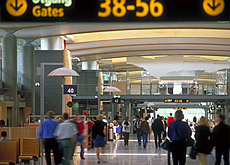Norway: a case study for Swiss-EU ties?

Norway says it has benefited from joining the European Union’s passport-free Schengen area, and an initially sceptical public has embraced the idea.
Ahead of a nationwide vote on whether Switzerland should forge closer ties with the EU on security issues, swissinfo reports on the Norwegian experience.
The Swiss go to the polls next month to decide whether they should also be party to the Schengen accord, which does away with systematic border controls across 13 EU member states and Iceland.
Non-EU member Norway signed the accord in 2001, which granted the country access to the Schengen Information System (SIS).
“This is a very quick and efficient system and has improved our ability to go after criminals who committed a crime in Norway and then escaped the country,” said Tom Brunsell, deputy director general of the Norwegian justice and police ministry.
He told swissinfo that the authorities had made more arrests since police started tapping into the European database, and dismissed suggestions that opening the country’s borders had led to a rise in crime.
But Brunsell conceded that criminals and illegal immigrants were attracted by the lack of border checks.
“We knew this would happen in Norway. Therefore it is crucial to have access to the SIS and the Eurodac asylum database.”
Police officers across the country have been trained to use the electronic database as a working tool in their daily routine. They can directly call up information stored on wanted people and missing cars and other objects.
Customs checks
As part of Schengen, controls of Norway’s borders with Sweden and Finland were scrapped, but the customs authorities continue to carry out checks.
“We have also stepped up spot checks by police in areas near the border,” said Brunsell.
The busiest external Schengen border post in Norway is Oslo’s international airport.
The only terrestrial crossing outside the Schengen area is into Russia, in a remote and usually quiet region on the Barents Sea in the Arctic Circle.
But the biggest challenge for the Norwegian authorities is the long Atlantic coastline.
“It is an open secret that we do not have the resources to meet all requirements of the Schengen accord on the blue border,” admitted Brunsell, although he believes that tough weather conditions discourage smugglers and traffickers from taking this route.
Asylum
Looking back over four years of experience with the common information system, the authorities admit that there were some initial problems with the asylum database.
“Things have improved with the fingerprinting system, Eurodac, and we cooperate well with other countries, also in southern Europe,” said Sissil Pettersen, a senior immigration specialist at the ministry of local government.
She said it would be a special challenge for the new EU member states on eastern and southern borders to respect their commitments, because they will have to cope with many asylum applications.
For its part Norway saw asylum requests surge after 2000, but the number of applications has fallen back over the past three years.
“That’s been the case in most other European countries,” said Pettersen.
According to her, one of the reasons for the decline is that potential asylum seekers are deterred by the Eurodac fingerprinting system.
But Pettersen is concerned that immigrants will increasingly try to stay in the country illegally without applying for asylum.
“The issue is high on the agenda of immigration authorities all over Europe. Therefore we look forward to a specific visa-data system which will be implemented in a couple of years.”
Nordic Passport Union
A previous agreement between Nordic countries which allowed citizens to cross borders without showing their passports made it difficult for Norway to say no to Schengen.
Kim Traavik, state secretary at the Norwegian foreign ministry, said the Nordic Passport Union was a key element during parliamentary debates about the Schengen/Dublin treaties.
“When our Nordic neighbours decided to join Schengen we had to follow in order to maintain our quality of life,” said Traavik.
He added that people who were used to travelling freely across the entire Nordic region – in particular to Sweden – would have found it difficult to accept restrictions had Norway opted out of Schengen.
There is little in the way of public criticism of the Schengen regulations in Norway and Traavik refutes suggestions that the treaty compromised the country’s sovereignty.
“On the contrary. It made it possible to step up the fight against such things as organised crime and terrorism.”
Traavik told swissinfo he was concerned about moves to intensify cooperation with Brussels in the areas of justice and home affairs, but denied that becoming part of Schengen was a step towards full EU membership.
“The conventional wisdom is that it will take another two or three years before there will be a broad political discussion that might possibly lead to a new application for membership.”
There has been a recent swing in opinion polls in favour of membership, which Norwegian voters rejected in referendums in 1972 and 1994.
swissinfo, Urs Geiser in Oslo
Norwegian police say the SIS has allowed them to increase the number of arrests and fight international organised crime.
The crime rate has remained stable, while the number of asylum requests surged to a record 17,500 in 2002. But figures dropped by half in 2004.
Norway has cut welfare benefits to rejected asylum seekers in an effort to fight illegal immigration.
Non-EU member Norway entered the Schengen area in 2001.
Under the 1954 Nordic Passport Union, citizens from Norway, Denmark, Sweden, Finland and Iceland have been able to cross regional borders without showing their passports.
The busiest external border checkpoint is the international airport in Oslo, which handles more than three million people a year.
Other external borders are with Russia in the Barents Sea region (196km), and its long Atlantic coast.
The internal borders with Sweden and Finland are 2,355km long.

In compliance with the JTI standards
More: SWI swissinfo.ch certified by the Journalism Trust Initiative


You can find an overview of ongoing debates with our journalists here. Please join us!
If you want to start a conversation about a topic raised in this article or want to report factual errors, email us at english@swissinfo.ch.